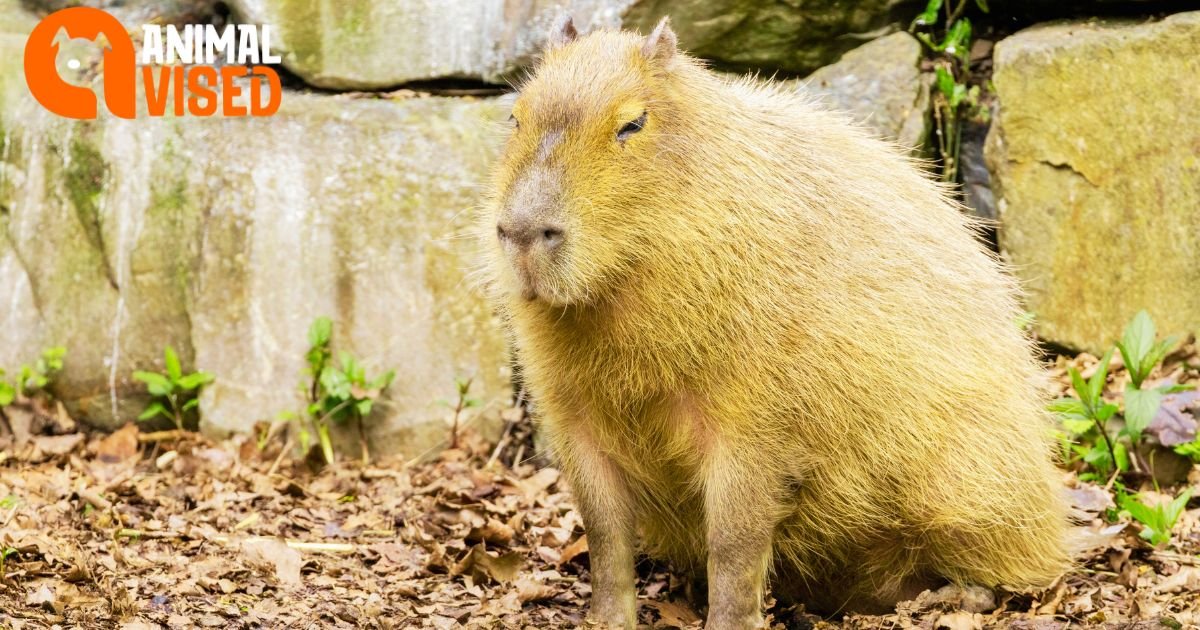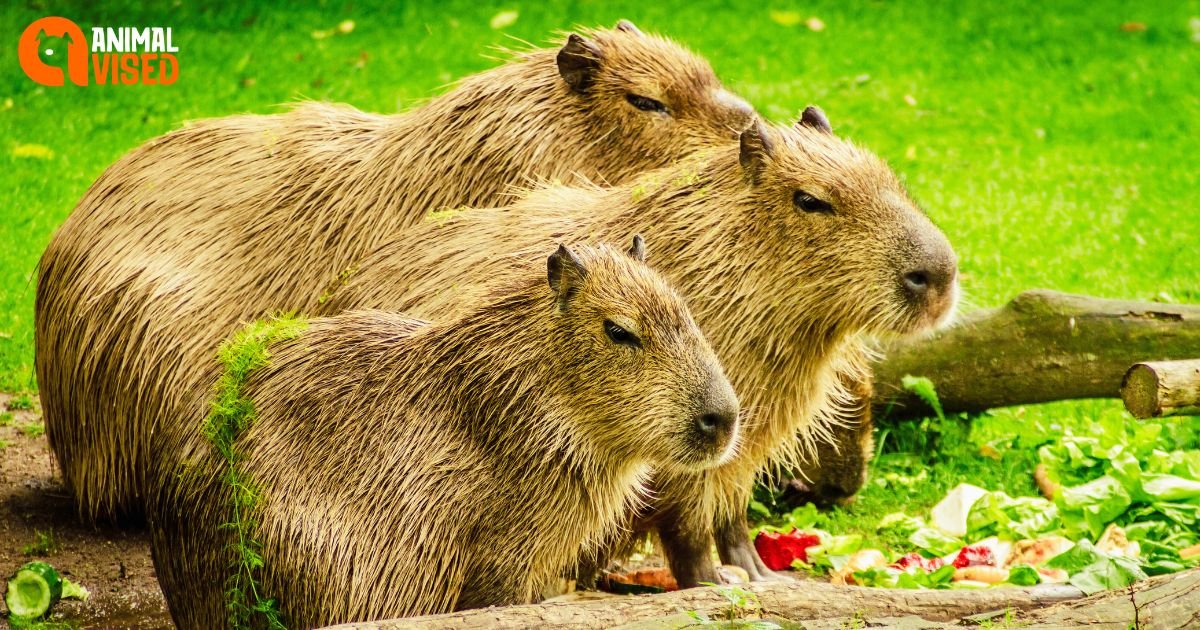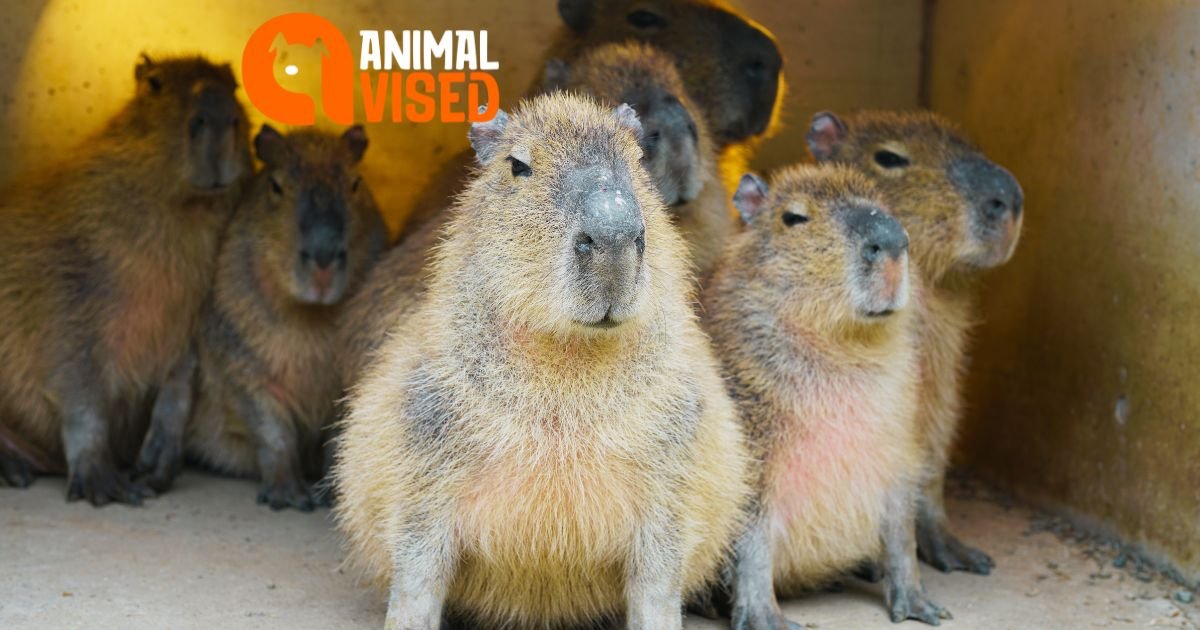Capybara
In the vast and diverse world of wildlife, few creatures capture the imagination quite like the capybara. These remarkable semi-aquatic rodents, native to South America, are not only the largest living rodents on Earth but also among the most fascinating and endearing animals you’ll ever encounter. With their gentle demeanor, unique physical features, and intriguing social dynamics, have earned a special place in the hearts of nature enthusiasts and animal lovers alike.
Read More: Celebrating Wombat Day

capybara size
One of the most striking aspects of capybaras is their imposing size. These herbivorous giants can grow up to 4.3 feet (1.3 meters) in length and weigh up to 145 pounds (66 kilograms), making them larger than many dog breeds. Their substantial size is a testament to their evolutionary adaptation to their semi-aquatic lifestyle, allowing them to navigate and thrive in the wetlands and waterways of their natural habitats.
Despite their formidable stature, capybaras are gentle creatures with a docile temperament. They are often seen lounging together in groups, basking in the sun or cooling off in the water, exhibiting a remarkable level of calmness and serenity.
capybara lifespan
In the wild, capybaras have an average lifespan of 8 to 10 years, although some individuals have been known to live up to 12 years or more under optimal conditions. Their longevity is influenced by various factors, including access to suitable habitats, availability of food and water resources, and freedom from predators and human interference.
In captivity, capybaras can enjoy even longer lifespans, with some individuals reaching up to 15 years or more when provided with proper care, nutrition, and veterinary attention. This extended lifespan allows captive capybaras to form strong bonds with their caretakers and other members of their social groups, further endearing them to those who interact with them.
where do capybaras live
Capybaras are native to South America, with their natural range spanning across parts of Brazil, Argentina, Uruguay, Paraguay, Bolivia, Colombia, Venezuela, and Ecuador. They thrive in various wetland habitats, including marshes, swamps, riverbanks, and flooded savannas.
These semi-aquatic rodents are heavily dependent on freshwater sources, as they spend a significant portion of their time in the water for both thermoregulation and protection from predators. They are excellent swimmers and can remain submerged for up to five minutes at a time, surfacing only to breathe.
While baras prefer wetland environments, they have also adapted to living near human settlements, often occupying parks, golf courses, and even suburban neighborhoods with access to water sources.
capybara diet
herbivores, and their diet consists primarily of grasses, aquatic plants, and various types of vegetation found in their wetland habitats. Their powerful jaws and continuously growing teeth are well-suited for grazing on tough, fibrous plants.
In addition to grasses and aquatic vegetation, capybaras also consume fruits, berries, bark, and even cultivated crops like corn, sugarcane, and melons when available. Their dietary preferences can sometimes put them in conflict with agricultural activities, leading to challenges in managing their populations in certain areas.
Capybaras are known to be highly efficient grazers, capable of consuming large quantities of vegetation daily. This trait helps them maintain their substantial size and provides them with the necessary energy to sustain their semi-aquatic lifestyle.
capybara appearance
The capybara’s appearance is a unique blend of striking features that set them apart from other rodents. Their barrel-shaped bodies are covered in coarse, reddish-brown fur that serves as insulation and protection against the elements.
One of the most distinctive features of capybaras is their webbed feet, which aid in their swimming and navigating through wetland habitats. Their partially webbed hind feet and robust tails further contribute to their aquatic capabilities, allowing them to maneuver gracefully in the water.
Capybaras have a rounded, blunt snout and small, protruding eyes that sit high on their heads, enabling them to keep watch for predators while partially submerged. Their nostrils are also positioned high on their snouts, allowing them to breathe while most of their bodies remain underwater.
Despite their size and semi-aquatic nature, capybaras are surprisingly agile on land, and capable of moving swiftly when necessary, although they generally prefer a more leisurely pace.
capybara scientific name
The scientific name for the is Hydrochoerus hydrochaeris. This taxonomic designation reflects the unique characteristics and evolutionary lineage.

The genus name “Hydrochoerus” is derived from the Greek words “hydro” meaning water, and “choiros” meaning pig or hog, referring to the capybara’s semi-aquatic lifestyle and their resemblance to small, plump pigs.
The species name “hydrochaeris” is also derived from Greek, with “hydro” again referring to water, and “choerus” meaning hog, further emphasizing the affinity for water and their pig-like appearance.
Together, the scientific name “Hydrochoerus hydrochaeris” aptly captures the capybara’s distinctive traits as a semi-aquatic, pig-like rodent, highlighting their unique evolutionary adaptations.
capybara predators
Despite their impressive size, are not immune to predation. In their natural habitats, they face threats from various predators, including:
- Jaguars: These powerful felines are among the primary predators of capable of taking down even the largest individuals with their formidable strength and hunting prowess.
- Pumas: Also known as cougars or mountain lions, pumas are opportunistic predators that will hunt capybaras, especially when their primary prey sources are scarce.
- Caimans and Crocodiles: These reptilian predators pose a significant threat to as they share the same aquatic habitats and are known to ambush and prey upon that venture too close to the water’s edge.
- Anacondas: The massive size and constricting power of anacondas make them formidable predators of capybaras, particularly when the rodents are resting or swimming in the water.
- Eagles and Large Birds of Prey: While not a major threat to adult capybaras, eagles, and other raptors may prey upon young or vulnerable individuals, especially when they stray from the safety of their social groups.
To protect themselves from predators, rely on their strength in numbers, forming large social groups and remaining vigilant for potential threats. Their semi-aquatic lifestyle also provides a refuge, as they can quickly retreat into the water for safety when necessary.
interesting facts about capybaras
fascinating creatures, and their unique traits and behaviors have captivated the interest of naturalists and animal enthusiasts alike. Here are some interesting facts about these remarkable rodents:
- Social Dynamics: Capybaras are highly social animals, living in large groups known as herds or troops. These groups can range from 10 to 40 individuals, with a complex social structure that includes dominant males, females, and their offspring.
- Friendly Nature: Despite their size, are known for their gentle and friendly demeanor. They are often seen lounging and grooming with other species, such as birds and monkeys, exhibiting a remarkable level of tolerance and cooperation.
- Excellent Swimmers: With their webbed feet and partially webbed hind legs, capybaras are exceptional swimmers. They can remain submerged for up to five minutes, surfacing only to breathe.
- Unique Cooling Mechanism: have a unique way of regulating their body temperature. They often seek out water sources and partially submerge themselves, allowing the water to evaporate from their fur, creating a cooling effect.
- Extreme Herbivores: are true herbivores, consuming a strictly plant-based diet. They have a unique digestive system that allows them to extract nutrients from tough, fibrous vegetation efficiently.
- Reproductive Habits: Female give birth to litters of 4 to 8 offspring after a gestation period of approximately 150 days. The young capybaras, known as pups, are born fully furred and can swim and graze shortly after birth.
- Unusual Hair Composition: fur is unique in that it consists of hollow, air-filled shafts, which aid in buoyancy and insulation when swimming or resting in water.
- Vocal Communication: Despite their gentle nature, are not silent creatures. They communicate through a range of vocalizations, including barks, whistles, and grunts, which are used to maintain social bonds and convey various messages within their groups.
- Conservation Status: While capybaras are not currently considered endangered, their populations are threatened by habitat loss, hunting, and conflicts with agricultural practices in some regions. Conservation efforts are underway to protect these fascinating rodents and their natural habitats.
- Popularity as Pets: In some parts of the world, have gained popularity as exotic pets due to their docile nature and endearing appearance. However, it’s important to note that keeping capybaras as pets requires specialized care and knowledge, as well as adherence to local laws and regulations.
The Capybara: South America’s Gentle Giant
(Hydrochoerus hydrochaeris), is a fascinating creature that holds the title of the world’s largest rodent. These social, semi-aquatic mammals native to South America have captured the hearts of many with their docile nature and surprisingly chill vibe.
This article dives deep into the world of the , exploring its size, lifespan, habitat, diet, appearance, scientific classification, predators, and some truly interesting facts that make this unique animal stand out.
Capybara Size
Capybaras are truly massive rodents. Adults can reach lengths of up to 4.3 feet (1.3 meters) and stand around 2 feet (60 centimeters) tall at the shoulder. Their weight can range from 79 to 174 pounds (35 to 66 kilograms), making them about the size of a large dog or a small person.
In comparison, their distant relative, the guinea pig, weighs a mere 1-2 pounds (0.5-1 kilogram).
Capybara Lifespan
In the wild, typically live for around 6-8 years. However, in captivity, with proper care and a stress-free environment, they can live up to 12 years.
The biggest threats to their lifespan in the wild are predators like jaguars, caimans, and anacondas. Additionally, habitat loss and human hunting can also impact their longevity.
Where Do Capybaras Live?
Capybaras are native to South America and can be found throughout the continent, except for Chile. They favor areas with abundant freshwater, such as:
- Dense forests near lakes, rivers, swamps, and ponds
- Flooded savannas
- Riverbanks in tropical rainforests
These semi-aquatic animals spend a significant amount of time in the water, using it to cool down, escape predators, and graze on aquatic plants.
CapyDiet
Capybaras are herbivores, meaning they primarily eat plant-based foods. Their diet consists mainly of:
- Grasses
- Aquatic plants
- Fruits
- Seeds
- Bark
They are grazers and spend a large portion of their day, particularly in the mornings and evenings, feeding on grasses near their water sources. Their digestive system is well-suited for breaking down tough plant material, similar to other herbivores like cows and horses.

Capybara Appearance
Capybaras have a unique and somewhat chunky appearance. Here’s a breakdown of their physical characteristics:
- Body: Barrel-shaped and stocky with short legs
- Fur: Short and reddish-brown or brown
- Head: Large and round with a blunt snout, small ears, and beady eyes positioned high on the head (an adaptation for seeing while mostly submerged)
- Tail: Almost nonexistent, just a small nub
- Feet: Partially webbed for swimming
Despite their large size, surprisingly agile swimmers and can even hold their breath underwater for up to five minutes!
Capy Scientific Name
The scientific name for the capybara is Hydrochoerus hydrochaeris. It belongs to the genus Hydrochoerus, which also includes the lesser (Hydrochoerus isthmus), a smaller relative found in Panama and Colombia.
are classified within the order Rodentia, making them the largest living rodent species. Interestingly, their closest relatives are guinea pigs, rock cavies, and more distantly, agoutis, chinchillas, and nutrias.
Capybara Predators
Despite their size, are not without predators. They face threats from several large carnivores in their South American habitat, including:
- Jaguars: These big cats are the biggest threat to adult especially on land.
- Caimans: These alligator-like reptiles lurk in the water and can prey on young or smaller.
- Anacondas: These large snakes can potentially constrict and kill adult , but such encounters are less common.
Living in large groups allows them to have more eyes watching out for danger and to confuse predators with a mass of bodies. They also use their swimming ability to escape threats on land by diving into the water.
Interesting Facts About Capybaras
Capybaras are full of surprises! Here are some fascinating facts that showcase their unique nature:
- Chill as Can Be: Known for their laid-back demeanor, capybaras are often seen relaxing in large groups, basking in the sun, or even cuddling up with other animals, including birds, monkeys, and even caimans (when they’re not being hunted!). This chill personality has earned them the nickname “Nature’s Peacekeepers.”
- Built for the Water: semi-aquatic and spend a significant portion of their day in the water. Their partially webbed feet, waterproof fur, and high-set eyes and ears make them well-adapted for aquatic life. They are excellent swimmers and divers, using their webbed feet for propulsion and their ability to hold their breath for extended periods to escape predators or graze on underwater plants.
- Vocal Communicators: These social creatures have a variety of vocalizations they use to communicate with each other. These include barks, whistles, clicks, and even purrs! Researchers believe these vocalizations are used for maintaining social cohesion, expressing dominance, and communicating danger.
- Precocial Young: Capybara young are precocial, meaning they are well-developed at birth and can walk and even swim shortly after being born. This allows them to stay close to the herd and flee predators quickly if needed.
- Cooperative Nursing: In a unique behavior, all the females in a capybara group will nurse each other’s young. This communal nursing system provides additional nourishment for the pups and strengthens the social bonds within the group.
- Fossil History: Capybaras have a long evolutionary history. Fossils of giant capybara relatives, dating back millions of years, have been discovered in South America. These extinct species were even larger than their modern counterparts!
- Capy Conservation: While currently listed as Least Concern by the IUCN, face threats from habitat loss due to agriculture and development. Additionally, hunting for meat and leather can impact their populations in some areas. Conservation efforts focus on protecting wetlands and raising awareness about the importance of these gentle giants.
Read More: Capybara
Conclusion
The capybara is a true marvel of nature, a unique and captivating creature that has captured the hearts and imaginations of people worldwide. From their impressive size and gentle demeanor to their remarkable adaptations and intriguing social dynamics, these semi-aquatic rodents are a testament to the incredible diversity and resilience of life on our planet.
As we delve deeper into the world of capybaras, we are reminded of the importance of preserving their natural habitats and ensuring the continuation of their species. Their presence in the wetlands and waterways of South America serves as a vital link in the intricate web of ecosystems, contributing to the overall balance and health of these environments.
FAQs:
Are capybaras dangerous?
No, baras are not considered dangerous animals. They are known for their docile nature and rarely show aggression towards humans. However, they are wild animals, and it’s best to observe them from a distance and not attempt to touch or pet them in the wild.
Can capybaras be kept as pets?
While some countries allow keeping baras as pets with proper permits and care, it’s generally not recommended. They require a lot of space, access to water, and specialized care. Additionally, their social needs are best met in large groups, which is difficult to replicate in a pet setting.
What is the relationship between capybaras and other animals?
Capybaras are known for their peaceful coexistence with many other animals. They are often seen sharing their habitat with birds, monkeys, and even caimans. This tolerance might be due to the benefits both parties gain. For example, birds might benefit from the capybaras stirring up insects while they graze, and capybaras might benefit from the watchful eyes of birds alerting them to predators.
What sounds do capybaras make?
Capybaras have a surprising range of vocalizations. They use barks, whistles, clicks, and even purrs to communicate with each other. Researchers believe these sounds are used for various purposes, including maintaining social order, expressing dominance, and alerting others to danger.
Are capybaras dangerous to humans?
No, are generally not considered dangerous to humans. They have a docile and gentle nature, and instances of aggression towards humans are extremely rare. However, it’s important to respect their space and avoid disturbing or provoking them unnecessarily.
Can capybaras be domesticated as pets?
While can be kept as pets in some regions, they require specialized care and a suitable environment to thrive. Domesticating these semi-aquatic rodents is not recommended due to their unique needs and the potential challenges of providing proper housing and care. Additionally, owning baras as pets may be subject to local laws and regulations.
How long do capybaras stay underwater?
excellent swimmers and can remain submerged for up to five minutes at a time before surfacing to breathe. Their partially webbed feet and dense fur help them navigate and stay afloat in the water.
Do capybaras make good parents?
Yes, are known to be attentive and protective parents. Female capybaras give birth to litters of 4 to 8 offspring, and both parents participate in caring for and protecting their young until they reach independence.
What is the purpose of capybaras’ barrel-shaped bodies?
The barrel-shaped bodies of serve several purposes. They provide buoyancy in the water, allowing the capybaras to float and swim with ease. Additionally, their compact shape helps conserve body heat and insulate them from the cooler temperatures of their aquatic habitats.
Are capybaras social or solitary animals?
animal are highly social animals, living in large groups or herds that can consist of 10 to 40 individuals. They exhibit complex social behaviors and hierarchies, with dominant males and females leading the group.
Do capybaras have any natural predators?
Yes, capybaras have several natural predators in their native habitats, including jaguars, pumas, caimans, crocodiles, and large snakes like anacondas. They rely on their strength in numbers and their ability to quickly retreat into the water for safety.
How do capybaras regulate their body temperature?
have a unique way of regulating their body temperature. They often seek out water sources and partially submerge themselves, allowing the water to evaporate from their fur, creating a cooling effect through evaporative cooling.
Are capybaras endangered species?
While capybaras are not currently classified as an endangered species, their populations are threatened by habitat loss, hunting, and conflicts with agricultural practices in some regions. Conservation efforts are underway to protect these fascinating rodents and their natural habitats.
What is the biggest threat to capybara populations?
The biggest threat to a populations is habitat loss and degradation due to human activities such as urbanization, deforestation, and agricultural expansion. Additionally, hunting and conflicts with farmers who consider as pests can also contribute to population declines in certain areas.











